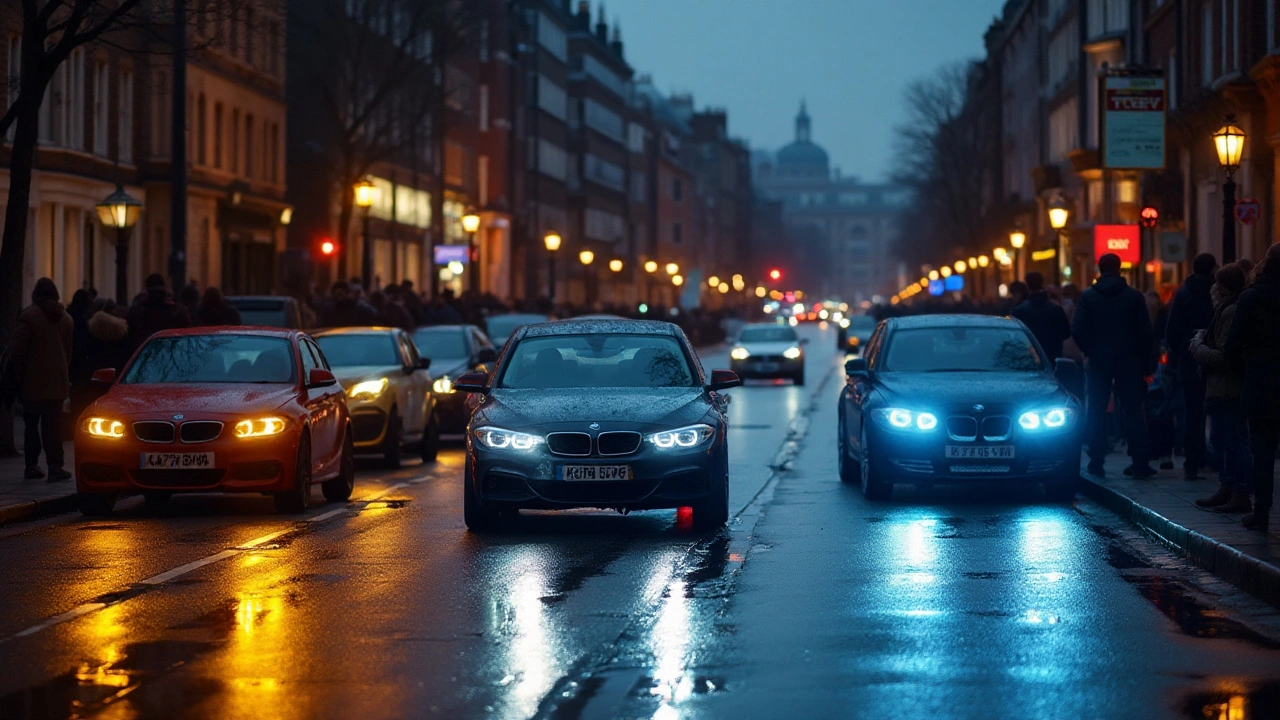When it comes to driving, lighting plays a critical role in ensuring safety, especially after dark. The color of your car's headlights isn't just about aesthetics; it can influence visibility and how you perceive the road. Whether you're navigating a bustling city or a quiet country lane, the right headlight color can make all the difference.
While white LED headlights have become increasingly popular for their brightness and clarity, there's a spectrum of colors to consider, each with its unique set of benefits. Some drivers might opt for cooler blue tones for a modern look, while others prefer warmer hues. The key is understanding what suits your driving environment and personal comfort.
In this article, we take an in-depth look at why headlight color matters. We’ll explore the mechanics behind LED lights, discuss how different colors can affect your vision, and share practical tips to help you choose the optimal light for your needs. So buckle up and get ready to see things in a new light—literally!
- Overview of Headlight Colors
- Advantages of White LED Headlights
- Comparing Different Colors
- Factors Influencing Headlight Color Choice
- Effect on Driving Visibility
- Tips for Choosing the Right Color
Overview of Headlight Colors
Choosing the right color for your LED headlights might seem straightforward, but there's quite a bit to consider. Traditionally, headlights used halogen bulbs that emitted a warm, yellowish glow. But with the arrival of LED technology, drivers have a range of colors at their fingertips, from the classic white to cool blues and even custom hues. These choices don't only affect the look of your vehicle; they can also change the way you experience your drive.
At the heart of color choice is the color temperature, measured in Kelvins (K). Lower numbers, around 3000 K, produce a yellow light similar to what incandescent bulbs offer. Increase this to 5000 K and you're looking at pure white—akin to midday sunlight. Go higher, around 6000 K to 7000 K, and the light starts to take on a bluish tint. These color variations can affect not only how far and wide you can see, but also how other drivers perceive you.
White LEDs are typically preferred for their ability to mimic daylight, which can reduce eye strain and improve visibility. However, they come with a trade-off. Some research suggests that extremely blue or white lights can cause more glare, which might not only be uncomfortable for you but also for oncoming drivers. On the flip side, yellowish lights, while softer, might not illuminate as far, making them less ideal for foggy or rainy conditions where visibility is crucial.
According to a study by the National Renewable Energy Laboratory, the majority of drivers tend to prefer and feel more comfortable under white LED light during night driving. They cite improved depth perception and color rendering of road signs and potential hazards. The study further emphasizes the significance of choosing the right headlight color for different driving contexts.
“The accuracy of object detection and the reaction time of a driver can be influenced significantly by headlamp color and intensity,” a researcher from the lab explained.This highlights the importance of considering both scientific findings and personal preferences when making a decision.
Understanding the contrast between different headlight colors and not just the hue itself could greatly influence road safety. The way our eyes detect and process colors can change based on factors like weather, roadway conditions, and even the age of the driver. For instance, older drivers may struggle more with blue lights at night due to increased glare sensitivity, prompting them to choose a warmer headlight color.
It's clear that your choice of headlight color can affect more than just the aesthetics of your vehicle. It plays a crucial role in ensuring your and others' safety on the road. As you consider which headlight colors are best for you, it might be helpful to account not only for your visual comfort and style preference but also the driving conditions you most frequently encounter. Doing so can lead to a more pleasant and safer driving experience, whether you’re cruising down brightly lit city streets or navigating through rural roads.
Advantages of White LED Headlights
White LED headlights have surged in popularity over recent years, and there are several compelling reasons why they are often considered the superior choice for drivers. Unlike traditional halogen bulbs, which emit a yellowish light that may strain the eyes over time, modern LEDs produce a crisp, white light that closely resembles daylight. This natural brightness reduces eye strain during nighttime driving, providing a clearer view of the road ahead and enhancing safety by making it easier to spot obstacles and pedestrians.
One of the most significant benefits of white LED headlights is their energy efficiency. LED technology consumes considerably less power compared to halogen and HID (High-Intensity Discharge) lights, which translates into less strain on your vehicle's electrical system. This efficiency doesn't just save energy but can also contribute to the longevity of your car's battery life. Additionally, LEDs have a much longer lifespan—typically lasting up to 25,000 hours compared to the 1,000-hour lifespan of traditional bulbs, minimizing the need for frequent replacements.
Moreover, white LEDs offer excellent performance in various weather conditions. Their brighter, more consistent light cuts through the darkness better than other lights, providing superior visibility in rain, fog, and even snow. According to a study by the IIHS (Insurance Institute for Highway Safety), vehicles equipped with LED headlights received better performance scores in low-light testing, indicating their effectiveness on the road. In dry conditions or inclement weather, you can count on this technology to maintain steady illumination, which is crucial for safe driving.
Some experts also emphasize the aesthetic appeal of white LED headlights, which often give vehicles a sleek, modern appearance. Car enthusiasts appreciate the clean look and the way LEDs can transform the presence of a vehicle. On the performance side, LEDs light up instantly, unlike some other types of lights that require warm-up time. This rapid response is beneficial in scenarios where quick light activation is needed, such as flashing your lights to alert other drivers.
While preferences can vary, the demand for white LED lights is underscored by their growing use in new vehicles released by manufacturers worldwide. To quote Car and Driver Magazine:
"White LEDs have become the standard for many car models due to their durability and efficiency, outperforming older technologies in almost every category."Even though there are cost considerations—the initial investment for LED lighting might be higher—many drivers find the benefits justify the expense due to savings over time and improved safety. By choosing a white LED setup, you're not only opting for a brighter, clearer view, but you're also making a more sustainable choice that's well-aligned with environmentally friendly practices.

Comparing Different Colors
Choosing the right color for your LED headlights isn’t just a matter of taste; it's about finding what serves you best during different driving conditions. The most common headlight colors available today are white, blue, and yellow, each with its own set of pros and cons. Let's dive into what each color offers and how it can affect your driving experience.
White LED headlights are recognized for their crisp, bright illumination. They tend to mimic natural daylight, which can make them particularly effective at improving visibility during night-time driving. The clarity that white lights provide can enhance your ability to spot hazards ahead, something that is crucial when navigating poorly lit roads. Interestingly, the trend of opting for white headlights has seen a marked increase over the years as the brightness they offer is unparalleled, giving drivers added confidence in tackling dark roads. Despite this, some drivers find white lights to be harsh on the eyes, particularly during heavy fog or snowy conditions, which can cause light to reflect and lead to glare.
Next, we have blue LED headlights, which have slowly gained popularity due to their modern appearance. Often noted for their stylish, cool hue, blue lights can make a car stand out on the road. They're not just about aesthetics, though. Blue lights may enhance contrast on the road, helping you pick out details that a white light might miss. However, there's a drawback; the bluish tint can be less effective when penetrating rain and fog compared to yellow or white lights. This limitation means drivers need to weigh the visual appeal against practical functionality.
A traditional favorite among some drivers is the yellow headlight. Known for their warm glow, yellow lights are less likely to cause glare, making them a good option for adverse weather conditions like fog or rain. The softer hue helps reduce eye strain for oncoming drivers, which might contribute to safer driving environments. A study from the University of Michigan found that drivers using yellow headlights reported less eye strain during extended night driving. Yet, it's important to note that while functional in bad weather, yellow lights may not be as bright as their white or blue counterparts, potentially making them less effective in standard night conditions.
To give you a better comparison, here's a quick reference in terms of light penetration and visual comfort:
| Color | Light Penetration | Visual Comfort |
|---|---|---|
| White | High | Moderate |
| Blue | Moderate | Moderate |
| Yellow | Low | High |
By understanding the dynamics of each headlight color, you can make a more informed decision that best aligns with your driving needs and conditions. Remember, the ideal choice often balances personal preference with the practicalities of where and how you drive the most. Whether you value clarity, style, or comfort, aligning your choice with these factors will ensure a safer and more enjoyable driving experience.
Factors Influencing Headlight Color Choice
Choosing the right color for your LED headlights can come down to a number of factors, extending far beyond mere preference. As drivers become increasingly aware of how light affects visibility, safety, and aesthetics, understanding these factors matters more than ever. First and foremost, your choice hinges significantly on driving conditions. For instance, those residing in rural areas with infrequent street lighting might opt for crisper, whiter lights to better illuminate long stretches of road. Their urban counterparts, navigating well-lit streets, might prioritize color hues that reduce glare and reflection.
Another consideration is the weather. Different headlight colors perform variably under various weather conditions like rain, fog, or snow. Warmer colors may penetrate fog and rain better, improving visibility where it’s most needed. Meanwhile, whiter colors could illuminate wet roads with less effectiveness, potentially dazzling oncoming traffic, thereby becoming a safety concern. As seasoned drivers might affirm, “The right light can make the difference between clarity and confusion on the road.”
“Research shows that different colors penetrate atmospheric conditions differently, affecting both driver vision and safety.” – National Highway Traffic Safety Administration.
One cannot ignore legal regulations when selecting headlight colors. In many parts of the world, safety standards dictate permissible headlight colors. In many countries, headlights must emit either white or yellow light, with any deviation potentially resulting in a hefty fine or mandatory replacement. It’s always wise to verify the local laws before making any modifications to your vehicle’s lighting system because adhering to these legal requirements ensures both safety and conformity.
Finally, technological advancements in car lighting have introduced headlight systems that adjust colors based on specific conditions, intelligently balancing brightness with safety. While these options can be quite appealing, they also increase the complexity and cost of installation and repairs. For those with budget considerations, it’s important to weigh the benefit of advanced lighting technologies against their financial implications.
In conclusion, choosing the right headlight color requires a balance of practicality, legality, and preference. Awareness of these factors helps ensure that drivers not only enhance their nightly journeys but also contribute to overall road safety. Such knowledge empowers motorists to make informed decisions that reflect both their personal needs and broader community standards.

Effect on Driving Visibility
Driving at night can be challenging, and the color of your car's LED headlights can significantly impact how well you see and react to the road ahead. White LED headlights are often preferred for their intense brightness and ability to mimic daylight, providing a clearer and crisper view of the road. This natural light spectrum can help reduce eye strain during long drives and enhance visibility in low-light conditions. On the other hand, some drivers feel that blue-tinted LEDs offer a slick, modern feel, though they can sometimes reflect off wet surfaces or fog, potentially causing glare. It's crucial to balance aesthetics with functionality when choosing your headlight color.
There's a fascinating science behind how headlight color affects visibility. Our eyes perceive different colors differently under various lighting conditions. A white light source contains all colors and provides the highest color rendering index, making it easier to detect obstacles and road signs as they appear more realistic. In contrast, yellow or amber-colored lights, though soothing, don't offer the same detail level and may slightly hinder the ability to spot objects that blend into the environment. Interestingly, a study published in the Journal of Illumination Science reported that 60% of drivers found white LED headlights enhanced their ability to recognize objects at night compared to traditional halogen lights.
The European Automobile Manufacturers Association notes, "Optimal headlight color should ideally match the natural illumination the human eye is accustomed to during the day, significantly improving drivers' response times and increasing overall road safety."This highlights the growing consensus that the closer the headlight color to natural light, the better it is for visibility.
Visibility isn’t just about what you see directly in front of you. Peripheral vision plays a crucial role in safe driving, especially in detecting movement from the sides, such as other vehicles, pedestrians, and wildlife. White or neutral LEDs can extend your field of vision, helping you capture these peripheral details more effectively. Nighttime drivers, especially on highways or remote roads, will benefit from the expansive spread of light that high-intensity LEDs provide. However, it’s essential to ensure these lights are angled correctly to avoid dazzling oncoming drivers, which could compromise their visibility and safety. Adjustments can usually be made in your vehicle's settings or with manual tilt adjustments from a trusted mechanic.
Moreover, different weather conditions will impact your headlight color's effectiveness. For instance, during foggy or rainy conditions, some drivers prefer warm lighting, like amber, because it cuts through the haze more effectively than cooler hues, minimizing temporary blindness from reflected glare. A clever solution is to have adaptive headlights, where the car can adjust the hue slightly based on the situation. Operating these headlights during diverse weather conditions can be advantageous. However, these systems can be expensive and are generally found on high-end vehicles.
Safety experts continually stress the importance of regularly checking your lights to ensure they are functioning correctly and emitting the intended amount of light. Dust, dirt, or oxidation on headlight covers can dim the output, undoing all the benefits of choosing the right color. Regular cleaning and maintenance should be part of every driver’s routine. If you're noticing a dimmer light, it might be time to clean the lenses or replace the bulbs. Maintaining your headlights is just as vital as selecting the appropriate color for optimal visibility and safety on the road.
Tips for Choosing the Right Color
Choosing the right color for your LED headlights is more nuanced than one might initially think. It's not just about personal preferences or what looks good on your vehicle. The choice can directly affect how you perceive the road and your safety. Firstly, consider where you do most of your driving. If you're primarily driving in urban areas with well-lit streets, a simple white or slightly bluish tone might be more beneficial as they are typically brighter and can provide clarity amidst streetlights. Conversely, those driving through rural or poorly lit areas may require a color spectrum that enhances contrast and helps highlight road edges and hazards, allowing for a safer journey.
The science behind headlight color is rooted in human vision. Different colors can lead to varying levels of eye strain for different individuals. For example, while pure white light might seem like an obvious choice for clarity, it often causes more glare on wet roads. Studies suggest that warmer colors may reduce this effect, increasing comfort during driving. Interesting studies have been conducted indicating that around 60% of drivers experience less eye strain when driving with LED colors that have a slight yellow tint. This reduction in strain can translate into longer and more comfortable drives without the need for frequent breaks.
"The best color for headlights is one that doesn't just light up the road, but increases the overall comfort and visibility for the driver in various environments," says Dr. Emily Sanders, a specialist in automotive optics.Another aspect to consider is local regulations. In some places, the use of lights that are seen as too far removed from the traditional white or yellow might not be legal. Before making a change, it's prudent to check what is permitted in your area to ensure compliance. There's no point in investing in new headlights only to be fined or to have to reverse the decision.
Additionally, think about maintenance and technology. Some headlight systems offer adjustable colors that change depending on the time of day or the driving conditions. This changing feature can be handy for those who don't want to be stuck with one color. Keep in mind, however, that advanced systems might come with higher maintenance needs and costs. Here’s a quick checklist to consider:
- Assess your most common driving environments: urban vs rural.
- Understand the glare and reflection properties of wet roads.
- Check local legal restrictions regarding headlight colors.
- Consider your comfort level and any history of eye strain.
- If available, explore adaptive lighting technology that can adjust conditions.
As with many aspects of vehicular enhancement, personal safety and comfort should take priority. With a thoughtful approach and the right information, choosing the right headlight color can transform your driving experience from just plain visibility to dependable clarity in all conditions.






